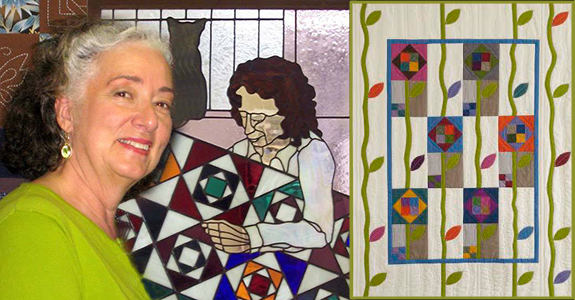
Pepper Cory, and a quilt, Fresh Flowers, made in 2014.
Q&A: PEPPER CORY
Quilt retailers—both online and in bricks-and-mortar shops—all seem to have a common question, “How can I keep up with every new trend in quilting to keep my inventory fresh and exciting and ensure my customers are satisfied?”
To be sure, the answers are as complex as the question, but quilt expert Pepper Cory may be able to shed some light on this topic at the International Quilt Market in Minneapolis. Her presentation, “What’s Up with Modern Quilters, Badass Quilters, and Slow Quilting?”, from 9 to 10 a.m., Thursday, May 14, will address these unique quilting subcultures and how to market to them.
A former quilt shop owner herself, Pepper has been involved in quilting since 1972 when she bought her first antique quilt for $1 at a rummage sale. Since then, this avid collector and designer has been busy teaching, lecturing, and writing about the art of quilting, with seven books published. She has taught in almost all 50 United States and in Canada, Holland, Belgium, Germany, France, England, New Zealand, and Australia.
In this issue of eInsider, she shares some of her insights and tells what Market attendees can expect to learn from her presentation.
eINSIDER: Why does the world of quilting require new subcategories and niches to define specific movements?
CORY: The topic is one I've wanted personally to explore for some time. It seems our beloved craft is so large it's spawning sub-genres and trends. While we've always experienced fabric fads—from scads of Scottie dogs to an enduring love affair with batiks—quiltmaking also has its philosophical differences. All three of these movements were started by people who felt their needs were not being met within the context of traditional quilting.
The sub-categories have been there for a long, long time, but we are a much more literate bunch of people than we used to be. People are writing blogs and writing articles. We are thinking and writing about this craft more, and when people write, they want to delineate the subject. A lot of that is simply recognition of something that has been there for a long time.
------------------------------------------------------------------------------------------------
eINSIDER: How would you describe the differences between these three groups you will be discussing in your presentation?
CORY: Modern Quilting has its own aesthetic (style) and has changed the palette of many quilting customers. It's more than a movement—it's an important economic presence in our market.
Other influences, such as Slow Stitching, are up-and-coming and not as commonly felt or understood. Does Slow Stitching mean we have to go back to scissors and templates and sew by hand? Certainly not! It's about quality time, quality resources, and thoroughly enjoying what you do. I was surprised to learn that the self-styled "bad boy" of quilting, Mark Lipinski, is taking Slow Stitching very seriously. Slow Stitching is basically a wake-up call for anyone who's bored with quilting.
And then there are the BadAss girls. Is it a biker gang or just quilters with attitude? Does being a badass resonate with you at all? In the context of finding your best retailing strength and showing your customers who you are and what you believe in, are you a badass or someone who just floats along with every whim in the market? Basically, what do you stand for?
------------------------------------------------------------------------------------------------
eINSIDER: Should we recognize other categories as well?
CORY: The other categories have always been there. If you mean, should we talk about them as separate categories, that is certainly up to the individual. Larger shows and organizations such as Quilts Inc. and AQS and those that control shows and competitive venues need to think very carefully about doing separate categories for different skills. Sometimes they view them as skills and sometimes they view them as categories. Categories are not always based on the same criteria. Some are apples, some oranges.
One of the prizes you might get is for handwork. That’s a technique. Another prize you might get is for embellishment or particularly fine machine quilting. Those are techniques. But then again, some of the categories are wall hangings, traditional bed-sized quilts, and miniatures.
You can see that delineating by size and then delineating by technique—and still putting them all as categories within a show—can be very confusing. This is just my personal opinion, but before setting an extra place setting at the table, we need to think carefully, “What does this do for quilting in general?”
------------------------------------------------------------------------------------------------
eINSIDER: Do these delineations create opportunities to expand the quilting market?
CORY: I think that retailers cannot afford to wait until salesmen turn up on their doorstep to look at what’s new in the quilting business. I think retailers can’t afford to not have an online presence, and not be aware of what’s being said on blogs and newsletters.
Anything that gets talked about a lot in quilting ought to be investigated. But before any shop adds inventory to service a certain segment of the market, they need to ask themselves, “Am I personally attracted to this? Can I stand behind this product? Am I knowledgeable about this new genre, this new technique?”
Women are great BS detectors. If they feel you’re trying to sell them something you don’t really believe in, they will know that. If you can stand behind and like—maybe even love—the products that you sell, those things are going to make a difference to your bottom line.
------------------------------------------------------------------------------------------------
eINSIDER: If you had the ability to forecast what the next big trend will be, what do you think we should be watching?
CORY: I’m looking very carefully at the Slow Stitching movement and what it is in a larger sense. It’s going to take a lot of explaining simply because the words “Slow Stitching”—if you just take it literally—means “work slow.” And that strikes fear in the hearts of retailers.
I think the implications of that, when defined, are mirroring what’s happening in our culture. People are becoming concerned about where their food comes from and where their energy comes from. They are becoming more aware that what they do is not just activity off here in the corner. Slow Stitching is very much about being aware of your place in the rest of the world.
There is a fourth category that didn’t make it into the description for this class and that is “Celebrate Hand Quilting.” I think it might come under the category of Slow Stitching. People who are enjoying hand quilting—whether they’re still doing it or they’ve gone back to it or they want to try it—are doing it as a therapeutic action.
It’s not a reaction against machine quilting. Here’s a wonderful statistic that I just love. I belong to a group on Facebook called “Celebrate Hand Quilting” that has more than 10,000 members worldwide. We also have members who are professional longarm quilters. They do that quite consciously—and they’re quite good at what they do for their living. They hand-quilt for themselves for fun.
I don’t think that either hand-quilting or slow-stitching is any kind of speed bump to the growth of retail stores.
People talk a lot and they write a lot about movements. A lot of that is just talking head stuff. Don’t pay attention to it; do what your gut tells you to do.
------------------------------------------------------------------------------------------------
UPCOMING SHOWS
2015
2016
International Quilt Market/Minneapolis
May 15-17
Classes begin May 14
Minneapolis Convention Center
Minneapolis, Minnesota, USA
Quilt! Knit! Stitch!/Portland
August 13-15
Classes begin August 13
Oregon Convention Center
Portland, Oregon, USA
International Quilt Market/Houston
October 24-26
Classes begin October 23
George R. Brown Convention Center
Houston, Texas, USA
International Quilt Festival/Houston
October 29-November 1
Preview Night October 28
Classes begin October 26
George R. Brown Convention Center
Houston, Texas, USA
International Quilt Festival/Chicago
April 7-9
Classes begin April 7
Donald E. Stephens Convention Center
Rosemont, Illinois, USA
NOTE: Quilt Market is a credentialed
trade show only, and not open to
the public.
For information on these or any other Quilts, Inc. shows, visit www.quilts.com
Subscribe to our eInsider Newsletter
©Quintessential Quilt Media, 2015. All rights reserved.
7660 Woodway,
Suite 550
Houston, Texas 77063
U.S.A.
Telephone (1) 713.781.6864
Fax (1) 713.781.8182
e-mail: shows@quilts.com

News and Trends from International Quilt Market
